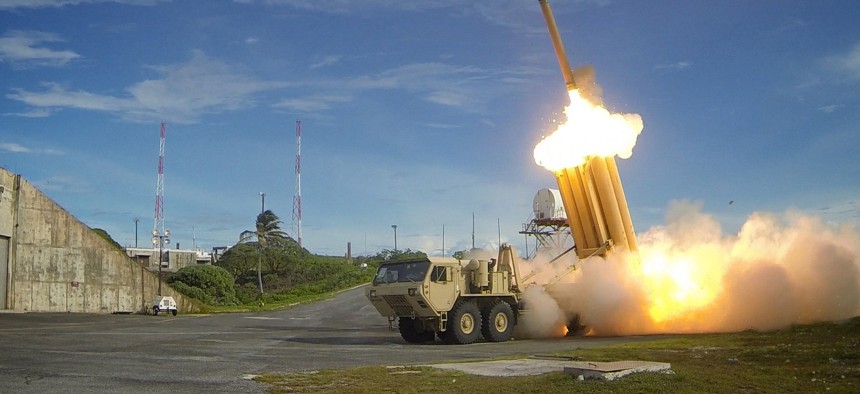
A Terminal High Altitude Area Defense (THAAD) interceptor is launched during a 2013 test. Missile Defense Agency
ISIS, Global Threats Boost US Arms Exports
Lockheed Martin, the world’s largest defense contractor, reported strong export growth, and it’s not alone.
A wide range of global threats posed by Islamic State militants and nations like Iran are continuing to fuel the sale of American-made arms around the world.
Despite slower domestic sales in the U.S., the foreign market remains ripe. Lockheed Martin, the world’s largest defense contractor, reported that foreign orders made up 21 percent of the company’s $46.1 billion in 2015 sales. That’s a six percent jump in foreign sales over the previous year.
“We continue to have growing international interest for our programs, particularly in the area of missile defense, in the Middle East, in Asia-Pacific and even in Europe,” Marillyn Hewson, chairman, president, and CEO, told analysts on Tuesday when the company reported its 2015 earnings.
The 18-month-old bombing campaign against ISIS has driven both munition and targeting equipment sales, Hewson said. Lockheed makes the Hellfire missile, one of the weapons frequently fired from American and ally aircraft and drones. It also makes the Sniper targeting pod, a device that allows an aircraft to pinpoint buildings and track people or vehicles on the ground.
Beyond ISIS, Middle Eastern countries have stocked up on missile defenses in fear of Iran’s ballistic missiles and nuclear weapons program. Lockheed makes a host of missile defense equipment, including THAAD and PAC-3 interceptors.
The company is expecting a THAAD order from Qatar in 2016, Bruce Tanner, Lockheed’s executive vice president and chief financial officer, said in the call.
“[W]e have other air and missile defense programs scattered throughout the region, but not nearly of the same size as we’re seeing in Qatar,” he said. “That’s the driver of the biggest international orders prospects as we see 2016.”
Threats from Russia, China and North Korea might also drive the increase.
“International demand for defense and military products is increasing as uncertainties brought on by regional tensions in the Middle East, Eastern Europe, North Korea, and the East and South China Seas may lead to increases in defense budgets,” a new Deloitte report states.
Foreign buys of the F-35 Joint Strike Fighter are also expected to pick up in the coming years as production of the warplane increases. Over the next five years, about 50 percent of F-35 orders will be from allies, Hewson said.
Lockheed delivered 45 F-35s last year, mostly to the U.S. military. The company is expected to build 53 F-35 this year.
Lockheed is not the only one seeing the boost overseas, according to the Deloitte report. Foreign buys of American military equipment jumped from $21.4 billion in 2010 to $46.6 billion in 2015, a 118 percent increase.
“It is likely that this trend will continue for not only US-based defense firms, but also European and Asian firms,” the report states.
